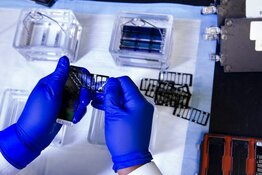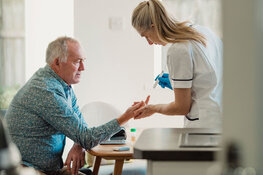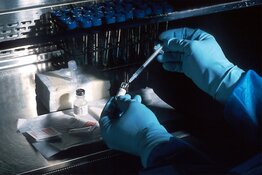The Life Sciences Report: When we spoke in April 2013, you said small-cap biotechs had not followed the large-cap indices upward. I believe we can safely say that small biotechs are catching up or have caught up. Where are we now in the small-cap biotech market valuation cycle?
Steve Brozak: Yes. More small companies are realizing and being recognized for their underlying value. I'd like to make a couple of observations. We've seen upward mobility in the initial public offering process for many companies that, frankly, have not been as well researched as they should have been. There has not been a visible path to product commercialization, as there should have been. I see the upward movement in biotech stocks as a commoditization trend. It's like when people said that gold was going to go to $5,000/oz. Investors have been buying into the biotech space as if it were the new commodity, so there's a bit more excitement than I'd like to see. That said, and although some companies we have covered have been taken over, there are still remarkable values within the biotech sphere.
TLSR: What about the indices? Certainly, we know that upward-moving indices help all stocks. Are the indices ready for a rest, or is there more upside to the broader biotech markets?
"We believe Athersys Inc. is still undervalued."
SB: For the broader biotech market, I would answer no. I don't believe the broader biotech markets are going to continue upward in an all-encompassing sense. Frankly, I've been very surprised by some transactions. To paraphrase a former Federal Reserve chair, have we seen “irrational exuberance?” No, but we have seen overenthusiasm in some cases.
TLSR: Steve, you always have a specific theme backing up your investment ideas. You are currently looking quite harshly at the healthcare system—particularly in the U.S., where you see a very flawed economic business and medical model. Bring me up to speed on your thinking here. What grand-scale malfunction do you see in the healthcare system?
SB: It's epitomized by the recent government shutdown. We literally went to the brink and shut the entirety of our system down based on polarization in how we want to move forward with healthcare. Most Americans are familiar with a system that has provided a level of care never seen in the history of medicine. The problem now is that this system has gone too far in terms of how it approaches expenditures. We simply can't afford it, and we don't have a system of checks and balances that works on healthcare expenditures.
"There is exciting potential for Cytori Therapeutics Inc.'s therapy."
When I say we can't afford it, I mean we can't afford a system that basically doesn't restore the health of an individual. We can't afford a system that provides the proverbial pill-a-day model. That model isn't satisfactory for the growth of the healthcare system, and it's certainly not satisfactory considering how sick our population is.
TLSR: You're saying that it's untenable for payers to continue to pay for the pill-a-day blockbuster products that ultimately support and grow the large pharmas. Is that it?
SB: Yes. Patients are divorced from the actual sticker prices of their drugs. They are responsible for a co-payment, and they don't suffer the sticker shock of how much these products actually cost. A moderately priced drug for hypertension that has not yet gone generic can run $1,000/month. In the same way, an interventional procedure can be in the high five figures. Who can afford to pay that?
TLSR: What is your solution?
SB: The first part is coming to grips with who has ultimately been the payer. It's always been the U.S. government. People have been happy to praise Medicare, which is the ultimate payer. Even corporate plans offer tax benefits to companies, and therefore the government has been paying for everyone's employee health insurance indirectly. Some people say the capital markets will understand this. No. No, they won't, because there is no transparency. Pricing is an example of this lack of transparency. The insurance industry and Centers for Medicare and Medicaid Services are considered the penultimate price setters. The reality is, the companies responsible for development and marketing of new drugs often base prices on their perceived value. We can't keep that kind of model forever.
"NeoStem Inc.'s initial trial data has been positive beyond expectations."
The solution involves—if you’ll allow me a baseball metaphor—getting on base, getting singles. Have you read the Michael Lewis book, Moneyball: The Art of Winning an Unfair Game, or seen the movie based on it? It's about Billy Beane and his work as general manager with the Oakland Athletics baseball team. The person who began that work and who was in charge before Beane took over—and who is now with the New York Mets—is Sandy Alderson, an attorney and former Marine Corps officer who basically came into the game without prejudices in terms of how to value players. Alderson said baseball was valuing the wrong things.
In the same way, if you speak with physicians or others in the healthcare field, they are looking at the wrong metrics. There's a wonderful passage in the movie when the scouts say a certain player doesn't resemble the athletic mold because he has a paunch. That means that Babe Ruth basically wouldn't have made it in today's baseball because he had a paunch?
For better or worse, we're at a critical juncture. We need to look at strategies that no longer strive for the blockbuster product, such as a drug or device with the primary goal of revenue. We now need to focus on restorative medicine, and more important, on understanding the root causes of diseases, so we can address health issues prior to their becoming unacceptably burdensome to medical and financial well-being. In baseball parlance, I don't want to hit home runs every time I go out. I want to get on base, as in the Alderson-Beane model. I want to provide the best value for the money in terms of the best clinical outcomes.
TLSR: Steve, I'm assuming the stocks you currently recommend somehow fit the model you would like to see created here in the U.S. and globally. Go ahead and tell me how they fit that paradigm.
SB: Here's how they fit. The law of large numbers is going to preclude growth in pill-a-day returns. The law of large numbers is about growing revenue and earnings. If you're a pharma, you can double $50 million ($50M) in revenue in a year or two, but you can't double $5 billion ($5B) very easily. Investors look for growth of multiples—growth of revenue and earnings—but this cannot be sustained in the major pharma group of companies because they are so large already.
An exception to the pill-a-day model would be antibiotics, which are prescribed for a finite consumption period, not generally for chronic therapy. We now realize antibiotics are more important than we previously imagined, especially during flu season. Clinicians are accustomed to viewing viral attacks as non-antibiotic diseases, but the reality is—and published research in the "Journal of Infectious Diseases" is telling us this—bacterial infections can often occur simultaneously, when your system is weakened by a virus. Antibiotics will play an even greater role in modern medicine as new, multidrug-resistant strains of bacteria evolve. The lack of promising new antibiotic programs is also going to come to the forefront. The industry will have to do something about that.
In the long run, regenerative medicine is going to address medical objectives in a new way. Cell therapies will enable a self-contained healthcare mechanism in which patients achieve disease-modifying therapy or restoration of health, versus just regulation of disease. I believe governments, and I believe taxpayers, and I believe individuals, will pay higher prices for outcomes like this. The restoration of a person's health is what we're looking for, and that's an overarching theme.
TLSR: Let's talk about some companies.
SB: I'll start on the regenerative medicine side. Athersys Inc. (ATHX:NASDAQ) is a company we've talked about before and, in full disclosure, we at WBB Securities acted as a financial adviser on Athersys' last transaction.
"Investors have been buying into the biotech space as if it were the new commodity, so there's a bit more excitement than I'd like to see."
Athersys looks to provide a resolution of inflammatory conditions. The company's value has gone up but, frankly, we believe it is still undervalued. I would also mention, with regard to Athersys and many companies in the regenerative medicine space, that the Japanese government has realized that stem cell/regenerative medicine programs are almost nonexistent in that country, with only a handful of studies ongoing, versus hundreds of studies taking place in the U.S. and Europe. As a result, Japan's parliament passed legislation allowing companies to receive conditional approval for products even if efficacy hasn't been fully demonstrated yet, as long as the products are safe. That represents a much quicker pathway to approval in the Japanese market. Japan's Ministry of Health, Labour and Welfare will now develop and implement regulations to get this process moving.
TLSR: All a company needs is phase 2 data to get a regenerative medicine/cell therapy product conditionally approved in Japan. What does that mean to you?
SB: That means there is the potential for breakthrough technologies that was not heretofore possible. Now individual clinicians can try different things. True science and discovery are at an important moment in time. It's not possible, normally, to go from a handful to hundreds of studies in a short period of time, but it looks like that is what will happen in Japan. Athersys announced, on Jan. 9, that it had been granted three new patents in Japan that cover indications like stroke, graft-versus-host disease and inflammatory bowel diseases such as ulcerative colitis.
TLSR: In Q2/14, we're going to get the first data from Athersys' 128-patient phase 2 trial using MultiStem (multipotent adult progenitor cells) in ulcerative colitis. This program is partnered with Pfizer Inc. (PFE:NYSE). We’re going to get endpoints for all subjects through eight weeks following initial treatment. Then, later in Q2, the company plans to provide data through 16 weeks. I have two questions with regard to this. First, could the phase 2 data being derived for the U.S. Food and Drug Administration (FDA) be accepted by the Japanese regulators? Second, if the data are good, will investors consider this pivotal data and bid up this stock? By the way, Athersys is up 60% in the last four weeks and up 210% in the last 52 weeks.
SB: You've hit on a remarkably good question. In theory, it's possible that the Japanese regulators will accept the data, but ultimately it is data from Japanese trials that are accepted in Japan. To accept the U.S. data from the Athersys phase 2 trial would require a coordinated plan with the Japanese regulators. I don't want to go overboard and say a good phase 2 here in the U.S. would guarantee market acceptance in Japan, because that's not the way it's going to work. However, good data here cannot do anything but improve Athersys' potential for partnering, and improve everything across the board for later approval in Japan—and, by definition, in the rest of the world.
TLSR: Go ahead with another regenerative medicine name.
SB: Let's discuss Cytori Therapeutics Inc. (CYTX:NASDAQ).
TLSR: Cytori seems like an inefficient model because its platform is an autologous technology, where each individual patient's cells must be harvested and processed, whereas Athersys' platform is allogeneic, using single-donor cells expanded ex vivo into millions of doses. Does Cytori fit your efficiency model for the new paradigm?
SB: Producing Cytori's adipose-derived stem and regenerative cells (ADRCs; adherent stromal cells), is actually an efficient model because it is simple. The costs of goods sold (COGS) are minimal by comparison to therapies that do not work as well. Remember, it's not just an immediate economic or cost-saving benefit we're looking for—it is about obtaining a good result, with the potential for restoration of health.
"To paraphrase a former Federal Reserve chair, have we seen 'irrational exuberance?' No, but we have seen overenthusiasm."
The U.S. government—specifically the Biomedical Advanced Research and Development Authority (BARDA)—has backed this company, allowing it to demonstrate that it can repeat in animals what it has already done in people. The company can qualify for up to $56M in nondilutive development funding once it achieves BARDA milestones. What BARDA is looking to do is seed the field so new things can grow. The government would like to see tactical regenerative medicine demonstrated by clinicians—in Cytori's case, for treatment of radiation burns. Frankly, burns—whether from radiation or other sources—will be treated the same way. That's where there is exciting potential for Cytori's therapy. The ADRCs are produced by the company's Celution System, which is being vended now. Once the system is out there, clinicians will be free to use it in other capacities.
TLSR: Did you have another regenerative medicine name?
SB: NeoStem Inc. (NBS:NASDAQ) has two business models. It does its own manufacturing and outsources work through its Progenitor Cell Therapy (PCT) subsidiary, which it acquired in January 2011. PCT has collaborated with more than 100 companies or clients, one of which was Dendreon Corp. (DNDN:NASDAQ). PCT was the original collaborative outsource manufacturer of Dendreon's autologous cellular immunotherapy, Provenge (sipuleucel-T), the first cell therapy approved as a cancer therapeutic. PCT has a very cost-effective process, and we might have seen a different outcome in terms of COGS for Dendreon if it had stayed with PCT. NeoStem is replete with potential partners and technology.
NeoStem's other business model is the development and marketing of its own product. Through its Amorcyte subsidiary, NeoStem is positioned to take advantage of a global need for regenerative medicine by preserving heart function after heart attacks. In mid-December 2013, the company announced completion of enrollment in its phase 2 PreSERVE AMI trial with AMR-001 (autologous bone marrow-derived CD34+/CXCR4+ enriched cells), to preserve heart function following a severe myocardial infarction. The initial data has been positive beyond expectations. I would say that, statistically, the good results should continue. We are looking forward to hearing data at the end of the summer.
TLSR: That’s three regenerative medicine names. Any others?
SB: No—I'm moving into the antibiotics space. I've mentioned the connection to influenza, and we have had a vicious flu season. Cempra Inc. (CEMP:NASDAQ) is in clinical trials with solithromycin (CEM-101), which I think is the most important antibiotic to come along in a while. It will hit the market within a short period of time.
Solithromycin has proven itself repeatedly. It’s in phase 3 studies for oral and intravenous use for community-acquired bacterial pneumonia. Solithromycin is being tested as a step-down therapeutic, which means the same drug can be used in an oral or intravenous form. It is a money-saver for the healthcare system. A patient could come to the emergency room with a dangerous infection, be treated intravenously, and then be released once the infection is under control with the oral dose, rather than being admitted for several days to receive periodic intravenous medication. Cempra also is the beneficiary of BARDA funding. I like Cempra's technology very much, and the company has more than one antibiotic in development. It has a phase 2 candidate, Taksta (fusidic acid), in acute and chronic methicillin-resistant staphylococcus aureus (MRSA) infections and prosthetic joint infections.
Cempra is not only fully committed to developing antibiotics, it also has the ability to do it by itself. It is a strong company and has been able to attract partners from around the world. I believe that Cempra is primed to deliver. For full disclosure, we did act as a financial advisor on one of its transactions.
TLSR: Is there another antibiotic company in your quiver?
SB: Tetraphase Pharmaceuticals Inc. (TTPH:NASDAQ). Again, you're looking at a company that has an understanding of antibiotics and generations of experience. It has eravacycline (TP-434) in phase 3 studies for adult community-acquired complicated intra-abdominal infections. This is a broad-spectrum antibiotic that also can be used as a step-down therapy. Tetraphase is getting ready to start a phase 3 study with this product in complicated urinary tract infections.
TLSR: One of your themes is targeted therapeutics. Please address that.
SB: Some companies are developing technologies that elicit a specific response in patients who display a narrowly defined set of characteristics. Celldex Therapeutics (CLDX:NASDAQ) is studying rindopepimut (a fully human antibody conjugated to chemo agent monomethyl auristatin E) in glioblastoma multiforme (GBM) patients who are expressing epidermal growth factor receptor variant III (EGFRv3). Rindopepimut is specifically targeted to EGFRv3, which is overexpressed in 30% of GBM patients. This is specific targeting, and this antibody has demonstrated significant increases in overall survival in phase 2 studies. We expect phase 3 results in 2015.
TLSR: You still like Celldex even though it is up more than 370% in the last 24 months?
SB: Yes, I still like Celldex, and I'm still recommending it.
TLSR: Go ahead with another idea.
SB: Omeros Corp. (OMER:NASDAQ) has a therapy platform that targets inflammation, whether it be ophthalmic or in joints, specifically in arthroscopic surgery. The idea is to reduce inflammation, thereby reducing postoperative pain and providing for much better outcomes.
TLSR: The lead candidates at Omeros are combinations of drugs that have been on the market for ages. Would you imagine that the ophthalmologists and orthopedists who use these products currently on an off-label basis would shift over to the Omeros proprietary combinations once they are approved?
SB: Anecdotally, what I've seen is no consistency in the current standard of care. This bothers the FDA to no end. I think it would be easy for Omeros to single-handedly take the market.
TLSR: Another name?
SB: Before last November I was basically in a different camp with regard to Sarepta Therapeutics Inc. (SRPT:NASDAQ), saying that the company was overvalued. Sarepta is testing its antisense drug, eteplirsen (AVI-4658) in Duchenne muscular dystrophy (DMD). Sarepta management met with the FDA in November, and there was a very interesting outcome. The agency said, "We need to think about this more in terms of what the potential is going to be." The stock, obviously, lost a considerable amount of its value.
TLSR: You had Sarepta rated as a Sell, and you were right on target. When others on the Street were going negative on this story after the FDA meeting, you upped your rating to a Buy. The FDA said, on Nov. 12, 2013, that a new drug application (NDA) for eteplirsen would be "premature." The stock is up quite nicely since you went to a Buy.
SB: Thank you for that. This is one where I happen to like the technology very much, and that's why we have a Buy recommendation on the stock right now. Everyone was disappointed in the FDA meeting. To quote Sherlock Holmes, Sir Arthur Conan Doyle's fictional character, "You see, but you do not observe." What we observed was that Sarepta had every high-level FDA official in the building monitoring what was going on in that meeting. We looked at that as a very strong testament to the fact that the agency wants to work with the company. You see something like that and you say to yourself, "This is different." We say Sarepta is a good value.
TLSR: You can understand the FDA being cautious, and saying an NDA would be premature. The FDA based its decision, in part, on the failure of competitor Prosensa Holding N.V.'s (RNA:NASDAQ) antisense drug, drisapersen, in a phase 3 trial about six weeks earlier. That trial did not meet its primary efficacy endpoint. Why do you see Sarepta as being undervalued?
SB: Obviously, I want to see this product work and benefit the patients who are suffering significantly. But the idea is that this platform can be used in other indications. Generally, looking at other RNA-based technologies and companies, potential targets would include the universe of neuromuscular disorders. A short list would include indications such as Huntington's disease and amyotrophic lateral sclerosis (Lou Gehrig's disease).
TLSR: I know you have an important diagnostic company in your coverage. Tell me about it.
SB: That company is Navidea Biopharmaceuticals Inc. (NAVB:NYSE). In disclosure, we do have equity ownership in Navidea, based on our advisory services to the company.
This is an interesting company, but there's a disconnect with investors. Navidea's product, which was approved in mid-March 2013, is a targeted radiopharmaceutical called Lymphoseek (technetium Tc 99m tilmanocept). It is used intraoperatively, so that a surgeon using a handheld gamma detector can map the lymphatic system around solid tumors and detect metastatic cancerous tissue draining from the primary tumor site. So far it has been approved for melanoma and for a much larger indication, breast cancer. Lymphoseek is now gaining traction.
As for the investor disconnect, a lot of people don't understand the potential here. This is the most important product approval in the last 30 years in the oncology space—and that comes from the FDA, not from me. But it's a diagnostic, so how can the FDA say that? Because of the outcomes.
"The law of large numbers is going to preclude growth in pill-a-day returns."
Now the surgical oncologist can stage solid tumors like never before. The next disease indication will be head-and-neck cancer; the company has just finished up clinical trials in head-and-neck. After that, Navidea can start to think about sentinel lymph node mapping, which would make every solid tumor a potential treatment target. Because of the product's specifics, the company can think about targeting prostate, lung and colorectal cancer. Lymphoseek has such a low molecular weight that it can get into the very-hard-to-navigate lymphatic systems in each of these organs. It's never been possible to do that. Without a targeted diagnostic like Lymphoseek, a surgeon might never know if all tumor tissue is removed during surgery.
The stock price is down based on introductory sales, but the clinicians who are using Lymphoseek are coming back to use it again. It's one of those situations where investors are saying, "Well, how much revenue can Navidea really get from Lymphoseek?" I look at it and say, "In the U.S. and eventually in Europe, what is 100% market share and growing actually worth?" The fact that this product is designated as a targeted diagnostic makes it really important.
TLSR: Steve, the FDA granted fast track status to Navidea's Lymphoseek for squamous cell carcinoma of the head and neck back on Dec. 10, 2013. When can we expect approval for that indication?
SB: In speaking with one of the clinicians who was running the trial, he said there isn't any other diagnostic to use in this indication. Right now, you basically do a resection, meaning that you filet the patient. That's the way it is now. . .or you use this product. I can't speak for the agency, but I expect quick approval.
Keep in mind that this is one of those situations where, frankly, the Street has already sold off on the approval and the sales. I believe that, based on approval of sentinel lymph node mapping for head-and-neck cancers, we will see the first of two critical milestones for the Navidea franchise. The head-and-neck approval will allow for greater dissemination of clinician understanding. Concurrently, I believe the second and most critical milestone will be crossing the 50%-usage threshold, after which there can be no going back to the antiquated technology, which Lymphoseek will replace.
TLSR: Steve, you also follow medical device companies. Do you have something in this sector you'd like to talk about?
SB: Yes, Cyberonics Inc. (CYBX:NASDAQ). The stock has gone up considerably, nearly doubling over the past 24 months. I've covered this company for about seven years now. Its product has a simple concept. Basically, a wire is attached to the vagus nerve; that wire is then attached to a battery-powered pulse generator, which sends out pulses. This vagus nerve stimulation has potential to treat several different, specific, targeted indications. It is approved for use in preventing and treating epileptic seizures and what was heretofore untreatable depression, and it has the potential to treat chronic heart failure. The technology has provided some unintended but positive outcomes. I see this as the kind of medicine that allows for returns in multiple, targeted indications, and I think that is significant.
TLSR: Steve, I've enjoyed this, as always. Thank you.
SB: It's my pleasure. Thank you.
Stephen G. Brozak is a top-ranked analyst in biotechnology, pharmaceuticals and medical devices according to the Starmine ranking system and The Wall Street Journal. He has worked in the securities industry for more than 25 years, where he held positions in sales, management, investment banking, and research analysis. He is now the Managing Partner and President of WBB Securities, an independent broker/dealer and full-service investment bank. Brozak holds a bachelor’s degree and a master’s degree in business administration from Columbia University. He is a retired lieutenant colonel in the United States Marine Corps and currently is a member of the Secretary of Navy's Retiree Council, advising on healthcare issues.
Read what other experts are saying about:
Want to read more Life Sciences Report interviews like this? Sign up for our free e-newsletter, and you'll learn when new articles have been published. To see a list of recent interviews with industry analysts and commentators, visit our Streetwise Interviews page.
DISCLOSURE:
1) George S. Mack conducted this interview for The Life Sciences Report and provides services to The Life Sciences Report as an independent contractor. He or his family own shares of the following companies mentioned in this interview: None.
2) The following companies mentioned in the interview are sponsors of The Life Sciences Report: Athersys Inc., Cytori Therapeutics Inc. NeoStem Inc. Streetwise Reports does not accept stock in exchange for its services or as sponsorship payment.
3) Steve Brozak: I own, or my family owns, shares of the following companies mentioned in this interview: Navidea Biopharmaceuticals Inc. I personally am or my family is, paid by the following companies mentioned in this interview: None. My company has a financial relationship with the following companies mentioned in this interview: Athersys Inc., Cempra Inc., Navidea Biopharmaceuticals Inc. and NeoStem Inc. I was not paid by Streetwise Reports for participating in this interview. Comments and opinions expressed are my own comments and opinions. I had the opportunity to review the interview for accuracy as of the date of the interview and am responsible for the content of the interview.
4) Interviews are edited for clarity. Streetwise Reports does not make editorial comments or change experts' statements without their consent.
5) The interview does not constitute investment advice. Each reader is encouraged to consult with his or her individual financial professional and any action a reader takes as a result of information presented here is his or her own responsibility. By opening this page, each reader accepts and agrees to Streetwise Reports' terms of use and full legal disclaimer.
6) From time to time, Streetwise Reports LLC and its directors, officers, employees or members of their families, as well as persons interviewed for articles and interviews on the site, may have a long or short position in securities mentioned and may make purchases and/or sales of those securities in the open market or otherwise.












































